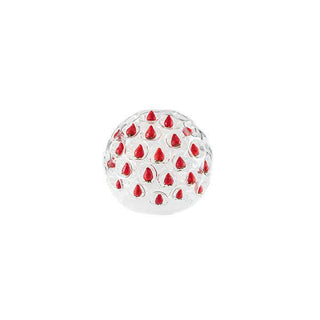H24cm
With her collaboration with the Réunion des Musées Nationaux Cire Trudon presents reproductions in various colored waxes. Napoleon is adorned with a wick, which pays homage to a candle's primary function, although the wax sculptures are meant to be collected rather than consumed.
As soon as the Consulate period began, Napoleon Bonaparte (1769-1821) realised the importance of showing his portrait to the French people. Then, the building of his legend began. All supports were used, from sculptures to snuffboxes and fans. The multiplicity of objects bearing the Emperor's effigy or representing imperial symbols was an extraordinary propaganda tool for the Napoleonic legend. During the Restoration, however, the Bonapartists were forced to hide and prepare their revenge, spreading more and more seditious objects. The death of the Emperor in 1821 made him less dangerous in the eyes of the realists and the copies that represented his main actions multiplied once again. The Second Empire (1852) made the imperial legend official with commissions of sculptures installed in squares and paintings exhibited in museums. Although the Second Empire re-established official propaganda, the fall of the regime in 1870 ended the celebration of Napoleon for 20 years. Nationalist fervour rose again in 1890 and since then has never ceased to be a heroic figure.
This fragrance was selected thanks to the partnership between Danilo Cascella Premium Store and Campomarzio70
H24cm
With her collaboration with the Réunion des Musées Nationaux Cire Trudon presents reproductions in various colored waxes. Napoleon is adorned with a wick, which pays homage to a candle's primary function, although the wax sculptures are meant to be collected rather than consumed.
As soon as the Consulate period began, Napoleon Bonaparte (1769-1821) realised the importance of showing his portrait to the French people. Then, the building of his legend began. All supports were used, from sculptures to snuffboxes and fans. The multiplicity of objects bearing the Emperor's effigy or representing imperial symbols was an extraordinary propaganda tool for the Napoleonic legend. During the Restoration, however, the Bonapartists were forced to hide and prepare their revenge, spreading more and more seditious objects. The death of the Emperor in 1821 made him less dangerous in the eyes of the realists and the copies that represented his main actions multiplied once again. The Second Empire (1852) made the imperial legend official with commissions of sculptures installed in squares and paintings exhibited in museums. Although the Second Empire re-established official propaganda, the fall of the regime in 1870 ended the celebration of Napoleon for 20 years. Nationalist fervour rose again in 1890 and since then has never ceased to be a heroic figure.
This fragrance was selected thanks to the partnership between Danilo Cascella Premium Store and Campomarzio70









